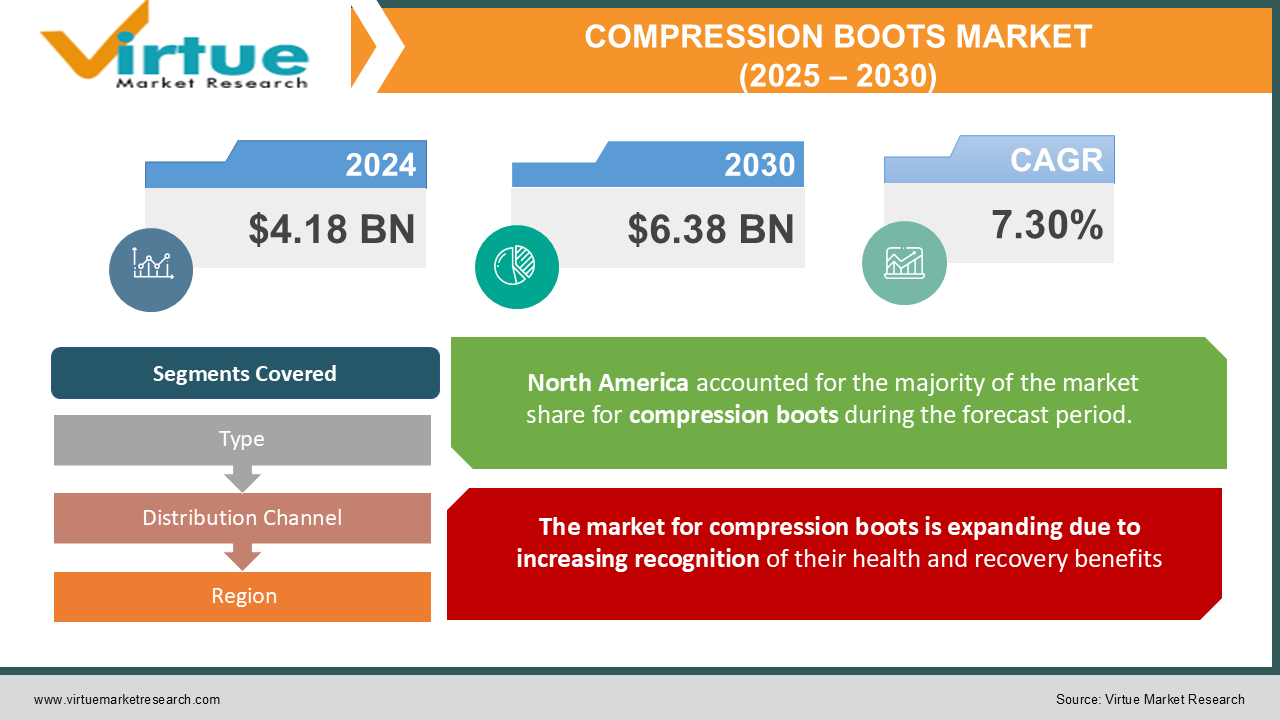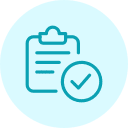Compression Boots Market Size (2025 – 2030)
The Compression Boots Market was valued at USD 4.18 Billion in 2024 and is projected to reach a market size of USD 6.38 Billion by the end of 2030. Over the forecast period of 2025-2030, the market is projected to grow at a CAGR of 7.30%.
The compression boots market has emerged as a dynamic and rapidly growing segment within the broader healthcare and wellness industry. These devices, also known as pneumatic compression boots, are designed to improve blood circulation, reduce swelling, and facilitate recovery, particularly for individuals involved in physically demanding activities such as sports and fitness. By delivering controlled, intermittent pressure to the lower extremities, compression boots help in promoting lymphatic drainage, decreasing muscle soreness, and preventing conditions such as deep vein thrombosis (DVT). The market is driven by an increasing focus on health, fitness, and post-injury recovery, as well as a rising prevalence of lifestyle diseases that require therapeutic interventions. As the global population becomes more health-conscious and technology-driven, the compression boots market is poised for sustained expansion, with a wide array of opportunities for manufacturers, distributors, and service providers.
Key Market Insights:
-
Compression boots accounted for 12% of the global compression therapy market.
-
78% of professional athletes in high-impact sports used compression boots.
-
The average retail price of compression boots in 2023 ranged from $500 to $1,200.
-
62% of fitness centers and gyms globally offered compression boot therapy sessions.
-
Over 35% of physiotherapy clinics reported a surge in demand for compression boots.
-
Consumer awareness campaigns increased sales by 22% year-over-year.
-
Direct-to-consumer online sales represented 40% of total market revenue.
-
Over 48% of surveyed users reported reduced swelling within 30 minutes of use.
Market Drivers:
1. The market for compression boots is expanding due to increasing recognition of their health and recovery benefits
The first and foremost driver propelling the compression boots market is the growing awareness of the health and recovery benefits these devices provide. Modern lifestyles, characterized by sedentary habits, poor dietary choices, and high stress levels, have contributed to a rise in circulatory disorders, muscle fatigue, and chronic pain. Compression boots address these concerns by offering a non-invasive, therapeutic solution to improve blood circulation, reduce inflammation, and promote muscle recovery. As consumers increasingly prioritize physical and mental well-being, products like compression boots have gained significant traction in both medical and non-medical settings. The widespread dissemination of information through online platforms, healthcare providers, and fitness influencers has also played a pivotal role in educating the public about compression therapy. Users are now more informed about how these devices can prevent serious complications like deep vein thrombosis, alleviate the symptoms of varicose veins, and enhance athletic performance. This heightened consumer awareness has led to an uptick in both inquiries and sales, with compression boots emerging as a preferred choice for those seeking effective recovery solutions. Advancements in product design and functionality have further bolstered demand. The introduction of user-friendly, portable models has made compression boots more accessible to a wider demographic. These devices are no longer confined to clinical settings; they are now popular among home users, fitness enthusiasts, and sports professionals. Smart features, such as personalized pressure settings, Bluetooth connectivity, and health tracking, have enhanced the appeal of compression boots, aligning them with the growing trend of wearable health technology.
2. Increased Adoption in Sports and Fitness
Another major driver fueling the market is the surge in adoption within the sports and fitness industry. Athletes, both amateur and professional, have embraced compression boots as a core component of their training and recovery regimens. High-impact sports like basketball, soccer, and running place immense strain on the muscles and joints, leading to fatigue, soreness, and injuries. Compression boots provide a targeted and efficient way to alleviate these issues, making them indispensable for athletes seeking to maintain peak performance. Sports medicine clinics and fitness centers have recognized the value of compression therapy, incorporating these devices into their services. Many gyms now offer recovery zones equipped with compression boots, catering to the growing demand for holistic fitness solutions. These facilities highlight the benefits of improved muscle recovery, reduced downtime, and enhanced athletic endurance, further solidifying the role of compression boots in the fitness ecosystem. Moreover, the global rise of recreational sports and wellness trends has expanded the customer base beyond elite athletes. Weekend warriors, fitness enthusiasts, and even individuals with casual exercise habits are now investing in compression boots to boost their recovery and overall performance. This shift has created a ripple effect, with manufacturers diversifying their offerings to cater to a range of consumer needs and budgets. The combination of professional endorsements, widespread availability, and tangible health benefits has made compression boots a staple in the modern fitness industry.
Market Restraints and Challenges:
While the compression boots market has seen substantial growth, it is not without its challenges. One of the primary restraints is the high cost associated with these devices. Quality compression boots equipped with advanced features such as mobile app integration, smart sensors, and portability often come with a hefty price tag, making them unaffordable for many consumers. Even though there are more affordable options in the market, these often lack the durability or functionality required to deliver the desired therapeutic benefits. This price sensitivity poses a significant barrier, especially in regions where disposable income is lower. Another pressing challenge is the lack of awareness among potential users, particularly in developing markets. Many consumers are either unaware of the benefits of compression therapy or perceive these devices as niche products intended only for professional athletes or clinical use. Misconceptions about their efficacy or necessity often deter individuals from making a purchase, further limiting market penetration. Manufacturers and distributors must invest in robust educational campaigns to bridge this gap, but this effort entails additional costs and resources. The market also faces challenges from competing technologies and solutions. Alternatives such as compression garments, manual massage, and physiotherapy services offer similar benefits at varying price points, providing consumers with multiple options. While compression boots are effective and convenient, some users may opt for these alternatives due to familiarity or cost considerations. Additionally, resistance from traditional healthcare providers who prefer proven, long-established treatments can slow the adoption of compression boots in medical settings. Durability and maintenance concerns further complicate market growth. Compression boots require regular cleaning, storage, and, in some cases, technical support to ensure long-term functionality. Malfunctions or breakdowns can lead to dissatisfaction among users, undermining trust in the product. Ensuring that devices meet high-quality standards while remaining affordable is a balancing act that manufacturers must navigate.
Market Opportunities:
The compression boots market presents a plethora of opportunities for growth and innovation. A significant opportunity lies in expanding the market reach to untapped demographics and regions. As the devices become more portable and user-friendly, manufacturers can target aging populations, casual fitness enthusiasts, and individuals with sedentary lifestyles. With targeted marketing efforts, these groups could form a substantial customer base for compression boots, especially as global awareness of wellness and recovery continues to rise. The integration of advanced technology represents another promising avenue. Features such as AI-driven personalization, IoT connectivity, and real-time health monitoring have the potential to transform compression boots from recovery devices into comprehensive health management tools. By collaborating with tech companies, manufacturers can develop products that not only offer compression therapy but also track vital signs, monitor recovery metrics, and integrate seamlessly with existing health apps. Such advancements could appeal to tech-savvy consumers and elevate the market to a new level of sophistication. The increasing trend of at-home fitness and wellness, accelerated by the COVID-19 pandemic, has created an environment ripe for direct-to-consumer sales. E-commerce platforms and subscription-based business models allow manufacturers to reach consumers directly, bypassing traditional retail channels. Bundling compression boots with complementary wellness products or offering affordable payment plans can further enhance their appeal. Collaborations with sports teams, fitness influencers, and healthcare providers offer another pathway for growth. By securing endorsements and building credibility within these communities, manufacturers can significantly increase the visibility and desirability of their products. Additionally, partnerships with insurers and employers to include compression boots in health and wellness programs could open up institutional sales channels, particularly in corporate settings where employee wellness is a growing priority.
COMPRESSION BOOTS MARKET REPORT COVERAGE:
|
REPORT METRIC |
DETAILS |
|
Market Size Available |
2024 - 2030 |
|
Base Year |
2024 |
|
Forecast Period |
2025 - 2030 |
|
CAGR |
7.30% |
|
Segments Covered |
By Type, Distribution Channel and Region |
|
Various Analyses Covered |
Global, Regional & Country Level Analysis, Segment-Level Analysis, DROC, PESTLE Analysis, Porter’s Five Forces Analysis, Competitive Landscape, Analyst Overview on Investment Opportunities |
|
Regional Scope |
North America, Europe, APAC, Latin America, Middle East & Africa |
|
Key Companies Profiled |
Normatec, Rapid Reboot, Air Relax, Recovery Pump, Thera body, Speed Hound, Doctor Life, RevitaPump, Bio Compression Systems, VYRE Recovery |
Compression Boots Market Segmentation - by Type
-
Basic Compression Boots
-
Advanced Compression Boots with Adjustable Pressure
-
Smart Compression Boots with App Integration
-
Custom-Fit Compression Boots
The most dominant type in 2024 was advanced compression boots with adjustable pressure settings, as they offer flexibility for users with varying needs. However, smart compression boots with app integration emerged as the fastest-growing type, driven by the rising demand for tech-enabled health solutions.
Compression Boots Market Segmentation - by Distribution Channel
-
Specialty Sports Stores
-
E-commerce Platforms
-
Hospital and Clinic Supply Chains
-
Fitness and Wellness Centers
In 2024, e-commerce platforms were the most dominant channel, accounting for the highest share due to convenience and wider product availability. The fastest-growing channel was fitness and wellness centers, where live demonstrations and trial sessions significantly boosted consumer interest.
Compression Boots Market Segmentation - by Regional Analysis
-
North America
-
Europe
-
Asia-Pacific
-
Latin America
-
Middle East & Africa
North America was the most dominant region, driven by a well-established fitness culture, high disposable income, and a strong healthcare infrastructure. Conversely, Asia-Pacific emerged as the fastest-growing region, fueled by rising health awareness, an expanding middle class, and increasing investments in fitness and wellness.
COVID-19 Impact Analysis:
The COVID-19 pandemic significantly influenced the compression boots market, both positively and negatively. On the positive side, the global focus on health and wellness accelerated the adoption of at-home fitness and recovery devices, including compression boots. Lockdowns and restrictions led to a surge in e-commerce sales, allowing manufacturers to reach consumers directly. The growing interest in non-invasive, drug-free recovery solutions aligned well with the features of compression boots, leading to increased demand during the pandemic. However, the market also faced challenges. Supply chain disruptions caused delays in manufacturing and delivery, impacting sales. Additionally, economic uncertainty led some consumers to prioritize essential spending over discretionary purchases, limiting the market's growth potential in certain segments. As the world transitions to a post-pandemic era, the lessons learned during COVID-19 are expected to shape future strategies for manufacturers, particularly in terms of supply chain resilience and digital marketing.
Latest Trends and Developments:
The compression boots market continues to evolve, shaped by trends that emphasize technology, accessibility, and consumer-centric design. One of the most notable developments is the integration of smart technology, enabling users to customize compression settings, track recovery progress, and receive real-time feedback through mobile apps. These advancements cater to the growing demand for personalized health solutions and align with the broader trend of connected fitness devices. Another significant trend is the shift towards lightweight, portable models that prioritize convenience without compromising functionality. This evolution has made compression boots more appealing to casual users who prioritize ease of use and mobility. Additionally, eco-friendly materials and sustainable manufacturing practices are gaining traction, reflecting consumer preferences for environmentally responsible products. The rise of wellness tourism has also boosted the market, with spas and resorts incorporating compression boots into their recovery and relaxation services. Moreover, collaborations between manufacturers and professional sports teams continue to drive innovation, resulting in products tailored to the needs of elite athletes. As consumer expectations evolve, the compression boots market remains poised for dynamic growth, with ongoing innovation at its core.
Key Players in the Market:
-
Normatec
-
Rapid Reboot
-
Air Relax
-
Recovery Pump
-
Thera body
-
Speed Hound
-
Doctor Life
-
RevitaPump
-
Bio Compression Systems
-
VYRE Recovery
Chapter 1. Compression Boots Market – Scope & Methodology
1.1 Market Segmentation
1.2 Scope, Assumptions & Limitations
1.3 Research Methodology
1.4 Primary Sources
1.5 Secondary Sources
Chapter 2. Compression Boots Market – Executive Summary
2.1 Market Size & Forecast – (2025 – 2030) ($M/$Bn)
2.2 Key Trends & Insights
2.2.1 Demand Side
2.2.2 Supply Side
2.3 Attractive Investment Propositions
2.4 COVID-19 Impact Analysis
Chapter 3. Compression Boots Market – Competition Scenario
3.1 Market Share Analysis & Company Benchmarking
3.2 Competitive Strategy & Development Scenario
3.3 Competitive Pricing Analysis
3.4 Supplier-Distributor Analysis
Chapter 4. Compression Boots Market - Entry Scenario
4.1 Regulatory Scenario
4.2 Case Studies – Key Start-ups
4.3 Customer Analysis
4.4 PESTLE Analysis
4.5 Porters Five Force Model
4.5.1 Bargaining Power of Suppliers
4.5.2 Bargaining Powers of Customers
4.5.3 Threat of New Entrants
4.5.4 Rivalry among Existing Players
4.5.5 Threat of Substitutes
Chapter 5. Compression Boots Market – Landscape
5.1 Value Chain Analysis – Key Stakeholders Impact Analysis
5.2 Market Drivers
5.3 Market Restraints/Challenges
5.4 Market Opportunities
Chapter 6. Compression Boots Market – By Type
6.1 Introduction/Key Findings
6.2 Basic Compression Boots
6.3 Advanced Compression Boots with Adjustable Pressure
6.4 Smart Compression Boots with App Integration
6.5 Custom-Fit Compression Boots
6.6 Y-O-Y Growth trend Analysis By Type
6.7 Absolute $ Opportunity Analysis By Type, 2025-2030
Chapter 7. Compression Boots Market – By Distribution Channel
7.1 Introduction/Key Findings
7.2 Specialty Sports Stores
7.3 E-commerce Platforms
7.4 Hospital and Clinic Supply Chains
7.5 Fitness and Wellness Centers
7.6 Y-O-Y Growth trend Analysis By Distribution Channel
7.7 Absolute $ Opportunity Analysis By Distribution Channel, 2025-2030
Chapter 8. Compression Boots Market , By Geography – Market Size, Forecast, Trends & Insights
8.1 North America
8.1.1 By Country
8.1.1.1 U.S.A.
8.1.1.2 Canada
8.1.1.3 Mexico
8.1.2 By Type
8.1.3 By Distribution Channel
8.1.4 Countries & Segments - Market Attractiveness Analysis
8.2 Europe
8.2.1 By Country
8.2.1.1 U.K
8.2.1.2 Germany
8.2.1.3 France
8.2.1.4 Italy
8.2.1.5 Spain
8.2.1.6 Rest of Europe
8.2.2 By Type
8.2.3 By Distribution Channel
8.2.4 Countries & Segments - Market Attractiveness Analysis
8.3 Asia Pacific
8.3.1 By Country
8.3.1.1 China
8.3.1.2 Japan
8.3.1.3 South Korea
8.3.1.4 India
8.3.1.5 Australia & New Zealand
8.3.1.6 Rest of Asia-Pacific
8.3.2 By Type
8.3.3 By Distribution Channel
8.3.4 Countries & Segments - Market Attractiveness Analysis
8.4 South America
8.4.1 By Country
8.4.1.1 Brazil
8.4.1.2 Argentina
8.4.1.3 Colombia
8.4.1.4 Chile
8.4.1.5 Rest of South America
8.4.2 By Type
8.4.3 By Distribution Channel
8.4.4 Countries & Segments - Market Attractiveness Analysis
8.5 Middle East & Africa
8.5.1 By Country
8.5.1.1 United Arab Emirates (UAE)
8.5.1.2 Saudi Arabia
8.5.1.3 Qatar
8.5.1.4 Israel
8.5.1.5 South Africa
8.5.1.6 Nigeria
8.5.1.7 Kenya
8.5.1.8 Egypt
8.5.1.9 Rest of MEA
8.5.2 By Type
8.5.3 By Distribution Channel
8.5.4 Countries & Segments - Market Attractiveness Analysis
Chapter 9. Compression Boots Market – Company Profiles – (Overview, Product Portfolio, Financials, Strategies & Developments)
9.1 Normatec
9.2 Rapid Reboot
9.3 Air Relax
9.4 Recovery Pump
9.5 Thera body
9.6 Speed Hound
9.7 Doctor Life
9.8 RevitaPump
9.9 Bio Compression Systems
9.10 VYRE Recovery
Download Sample
Choose License Type
2500
4250
5250
6900
Related Reports
Frequently Asked Questions
Key factors driving the growth of the compression boots market include rising awareness of fitness and recovery, increasing adoption among athletes and wellness enthusiasts, advancements in smart and portable designs, and growing demand for non-invasive therapeutic solutions. Additionally, expanding e-commerce platforms and heightened interest in personal health and wellness further fuel market expansion.
Main concerns in the compression boots market include high product costs, limiting accessibility, and a lack of consumer awareness, especially in emerging regions. Competition from alternative recovery methods, durability issues, and the need for regular maintenance also pose challenges.
Normatec, Rapid Reboot, Air Relax, Recovery Pump, Thera body, Speed Hound, Doctor Life.
North America currently holds the largest market share, estimated around 35%.
Asia Pacific has shown significant room for growth in specific segments.




